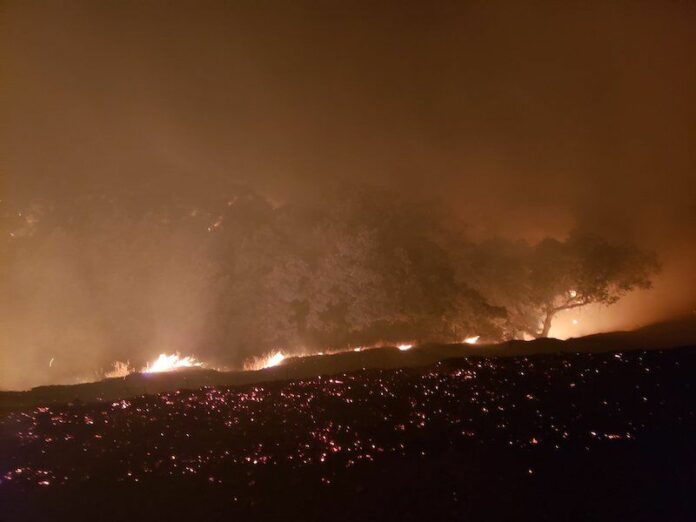As 2020 winds down, the Reveille will be taking time to reflect on the past year and everything that’s happened — from fires to a pandemic, Cloverdale has persevered. Despite barriers, the town came together for socially distanced or virtual events, supporting local businesses and more.
Over the coming two weeks, we’ll be sharing with you some of the highlights of the year.
Amid a tumultuous year of droughts, fires and viruses, Cloverdale worked hard on its emergency preparedness plans, with some of the city’s first decisions about how to get prepared for an emergency happening at the first city council meeting of the new year.
On Jan. 15, the Cloverdale City Council outlined its steps for developing a clearer emergency plan — namely, a schedule that outlines the steps to creating a resilience plan and when the city wanted them to occur. The last step approved by the council in January was to have a Resilience Action Plan by May 2020, and to hold a lunch event for the town. While the virus threw a wrench in the plan just two months later, Cloverdale’s emergency preparedness efforts continued throughout the year — albeit on a smaller scale.
In the beginning of March, a group of community gathered for a Resilient Cloverdale meeting to further engage in the city’s emergency preparedness initiative. The Resilient Cloverdale initiative, at its late-2019 inception was defined as an initiative to establish a community-based plan that helps better prepare Cloverdale for future emergencies.
The initial planning of Resilient Cloverdale was passed around a plan from the Neighborhood Empowerment Network, a program piloted in San Francisco that focuses on neighborhood connections as a way to form resource hubs during emergencies. At the March meeting, communities got together to work on marking maps of Cloverdale with where resources are or could be located — such as commercial kitchens, power hubs, large spaces and food sources.
In June, the Reveille covered efforts by the Cloverdale Citrus Fair to begin creating a plan of action for the fair should it become an evacuation center during a future fire. A group — Citrus Fair CEO Katie Young, former CEO Bonnie Wlodarczyk, Ed Bowen from The Church of Jesus Christ of Latter-day Saints in Cloverdale and James DeMartini — worked with the Red Cross to create an evacuation center plan, and solicited volunteers willing to participate in training as shelter managers.
Per our June article, the idea to create an emergency plan for the Citrus Fair came three years ago, following the 2017 fires. When the fires first hit, the then-CEO of the Citrus Fair, Wlodarczyk, received an early morning call saying that the Citrus Fair had been designated as an evacuation center. Shortly after that, Wlodarczyk and a group of others all worked to feed and house 300 people who were displaced.
“Bonnie and I have worked that kitchen together for 25 to 30 years, so we know it real well. It worked. Ed (Bowen) got his folks from the LDS Church and the other service clubs, Kiwanis primarily, kicked in and we fed and housed 300 people for 72 hours,” said DeMartini.
“We realized, Bonnie and I, that we had no idea how to operate like that. This was something brand new for us,” he continued.
After their experience in 2017, DeMartini said that they didn’t want to have to face a second evacuation event without a concrete plan for how to operate the fairground. Then, along came last year’s Kincade Fire. While the fair wasn’t a designated evacuation center during the October 2019 fire (it couldn’t be, due to lack of power), people still flocked to Cloverdale to seek food and a place to park their cars or trailers while evacuating the southern part of north county. People who had evacuated farther north also got stuck in Cloverdale on their way back, since many people tried to go farther north and then realized they wouldn’t be able to find enough gas to do so.
Three flocks of sheep called Cloverdale’s River Park home in June, as Falk Livestock and Land was brought in by Sonoma County Regional Parks to help with fire fuel reduction. Around 300 sheep stayed in the park for a number of weeks, grazing and helping with fuel management.
Early on in the pandemic a grim question arose: What happens if there is a wildfire and we need to evacuate despite the shelter in place order? The obvious answer was, you evacuate but with COVID-19 safety precautions in mind, such as mask wearing and social distancing.
In an eerie twist of fate the above scenario came true with the start of the Walbridge and Meyers fires in August and later the Glass Fire in September.
A rare summer thunderstorm that boomed across Sonoma County started two wildfires in west county in the week of Aug. 20 — the Walbridge Fire started west of Healdsburg and the Meyers Fire started north of Jenner.
As of Aug. 20 the Walbridge Fire was at 1,500 acres and growing at 0% containment and the Meyers Fire was at 25 acres at 0% containment.
With years of overgrown brush and dried tinder, the Walbridge Fire made its way down drainage basins and through the crowns of trees of redwood forests burning a total of 55,209 acres.
The fire — which was part of the LNU Complex Fire, a 363,220-acre fire composed of the Hennessy Fire, Walbridge Fire and Meyers Fire — forced the evacuation of several thousand Sonoma County residents including the residents of the Mill Creek Road neighborhood west of Healdsburg.
Cloverdalians didn’t have to evacuate, but were put on alert as the fire neared parts of Lake Sonoma.
For the duration of the fires, Cloverdale’s Community Organizations Active in Disaster (COAD) group met over Zoom multiple days a week, giving updates on where Cloverdale was at in its emergency plans.
“If that becomes a reality we could find ourselves in a similar situation as we were in during the Kincade Fire, where Cloverdale becomes an island,” City Manager David Kelley said.
Should Cloverdale not be under evacuation, Kelley and Young both anticipated that folks from evacuated areas would be heading up to Cloverdale to evacuate — and some already had.
Young said that people from Rio Nido and Hidden Valley Lake in RVs and trailers had already booked sites at the fairgrounds, which has overnight campsites available regularly, and noted that they received increasing calls from people who are looking to stay there.
As part of its preparedness efforts, the fairgrounds was pre-staged with cots, personal protective equipment and traffic control equipment.
On Aug. 26, Cloverdale issued a declaration of emergency, to open up reimbursement funds for what the city spent during the fires, since it had to open and man its emergency operations center.
The fire slithered its way into Armstrong Woods and devastated the Mill Creek Road area, including the historic Daniels School, which had been meticulously renovated in January.
A total of 1,491 structures were destroyed in the LNU Complex Fire.
While the fire affected the lives of many it also affected the fall grape harvest. As Dry Creek and Russian River valleys filled with smoke and an orange haze, some wineries had to halt their grape harvest due to the threat of the fire.
According to reporting by Rollie Atkinson, “Dozens of wineries lay along the periphery of the fire zones along River Road, Westside Road and in western Dry Creek Valley. Guerneville’s Korbel Winery ceased production work last Wednesday and diverted ripening grapes to its Bakersfield Heck Cellars. Elsewhere, the dangerous smoke-filled air has halted grape picking until the skies clear.”
In an end of August Sonoma County fire briefing, county supervisors stressed the importance of communities getting more prepared for fire season and District 4 Supervisor James Gore suggested that towns or areas form COAD groups — at the same time, Cloverdale was hammering out its own plan of action for developing a COAD — which is directly tied to its efforts with Resilient Cloverdale.
“We came up with this concept of Resilient Cloverdale — which kind of speaks for itself — to be more resilient,” Kelley said in an August interview with the Reveille. “To weather these events and come out with our health and wellbeing intact and to try to do that in a fashion that builds community at the same time.”
While the recent fires kicked the city’s planning process into overdrive, Kelley told the Reveille that there’s still work to be done. Daily meetings hosted by city staff at the peak of the Walbridge Fire resulted in some progress being made when it comes to making sure facets of the community and the city itself will be prepared for the next emergency — organizations and city entities now have bilingual signs that they can use to direct folks to resources around town, senior living facilities are making sure they have comprehensive emergency plans for their residents and work is being done to identify which city buildings need to be hardened in case they have to be used during an emergency.
Kelley said that one goal that he has is to make sure Cloverdale is prepared at both the neighborhood and community levels.
“The intent of the COAD I think is to really advance readiness at the neighborhood and community level and develop that relational framework so that organizations are talking to one another and talking about what resources they can bring to the emergency response process to help out with responding to disasters,” he said.
One key goal of the group is also making sure that more vulnerable members of the community — identified as seniors and people living with chronic conditions, members of the Latinx community, those who are food insecure, housing insecure, families with children, people with pets and residents who live in the Cloverdale area but outside of city limits — are communicated with in times of emergency, and that there are resources in place to help them.
“We’re trying to involve groups that traditionally didn’t have a seat at the table,” Kelley said. “There was a feeling after Kincade that we might not have done enough work upfront with our farmworker community and (trying to figure out) how do we reach out to them to ensure that we’re protecting them. They have a vital contribution to our community.”
As fire seasons run longer, Cloverdale’s preparedness efforts are still in the works, with many initiatives likely to continue into the new year.









